(See also this article at PBS MediaShift about the Creator Endorsed Mark, and this example of the mark being used in commerce.)
The Creator-Endorsed Mark is a logo developed by Questioncopyright.org and first used in June 2009 that a distributor can use to indicate that a work is distributed in a way that its creator endorses — typically, by the distributor sharing some of the profits with the creator. The mark is not an alternative to a free license; rather, it’s meant to be used in conjunction with free licensing. You release your work under a free license, and then grant or withhold permission to use the CE Mark based on how distributors behave.
As more and more creators freely circulate their works on the Internet, the mark provides a reliable way for non-exclusive publishers to signal to their customers that they are supporting the artist. The mark enables consumers to distinguish distributors based on how supportive of the artist they are, and to allow creators to encourage — not necessarily require, but encourage — particular methods of distribution for their freely-licensed work. Our experience is that given a choice, audiences will often prefer sources that support the artist, when they have a reliable way of recognizing such sources.
How it works:
A distributor may only use the mark with permission from the creator of the work, and creators may grant blanket permission to use particular versions of the mark to anyone who meets certain conditions. For example, the creator might say that anyone who shares any profits at all with them can use the generic “proceeds support” version of the mark:
Furthermore, a creator might grant permission to anyone who shares a certain percentage of their profits to use a “percentage” version of the mark, as long as it does not exceed the actual percentage shared. For example, a distributor sharing 25% of profits could use this mark:
Or an artist might grant permission to use a mark unrelated to revenue-sharing, because she endorses that distributor’s distribution for some other reason:
The default terms of the marks (see below) allow certain of these uses without prior permission, as long as reasonable conditions are met and the creator has not explicitly disallowed the use.
The marks come in “artist” and “author” versions:
…and in black-on-white versions:
The trademarks for these marks will be registered and held by QuestionCopyright.org (but note that we never charge for use of the marks — anyone may use them under these terms).
We define a “creator” to be the original copyright holder of the work, or in the case of public domain works, the person or entity that held the original copyright.
Any creator is free to grant others use of the marks in connection with the distribution of that creator’s work. Anyone other than the creator is free to use the appropriate mark when distributing works by that creator, so long as the creator has given permission for (“endorsed”) the use in question and the conditions for the mark continue to be met.
The creator may at any time prohibit a particular party from using the marks in reference to that creator’s work(s). (This gives creators a way to avoid being associated with distributors or causes that they do not approve of. The distributor might still distribute the work without the mark, but there will be no implication that the creator endorses that distribution.)
QuestionCopyright.org retains the right to alter these terms or the terms for any particular use in its sole discretion, which it may be likely to do if it finds that the use of the mark(s) is confusing or otherwise misleading.
Nothing in these terms of use grants you permission to distribute a work on terms other than those granted by the relevant copyright holder(s).
You may resize the marks, as long as their vertical and horizontal proportions remain the same, and you may change their foreground and/or background colors.
You are encouraged, but not required, to link back back to this article when using the marks online: http://questioncopyright.org/creator_endorsed.
Enforcement:
If you are a creator and someone is using the marks on your work in a way you disapprove of, please send them a letter telling them to stop, and make sure QuestionCopyright.org gets a copy of that letter (email is fine). If the disallowed use persists, let us know; we will either cooperate with you in enforcing the mark or grant you the necessary legal agency to enforce it yourself.
Credit:
The Creator-Endorsed Mark design was done by Nina Paley.
The marks:
(See here for a list of all available SVG files.)
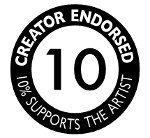 PNG / SVG / Encapsulated PostScript
PNG / SVG / Encapsulated PostScript
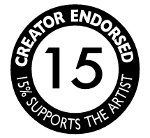 PNG / SVG / Encapsulated PostScript
PNG / SVG / Encapsulated PostScript
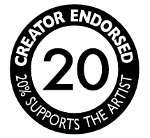 PNG / SVG / Encapsulated PostScript
PNG / SVG / Encapsulated PostScript
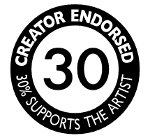 PNG / SVG / Encapsulated PostScript
PNG / SVG / Encapsulated PostScript
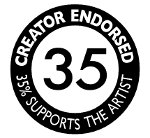 PNG / SVG / Encapsulated PostScript
PNG / SVG / Encapsulated PostScript
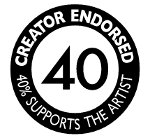 PNG / SVG / Encapsulated PostScript
PNG / SVG / Encapsulated PostScript
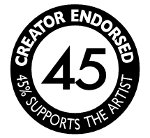 PNG / SVG / Encapsulated PostScript
PNG / SVG / Encapsulated PostScript
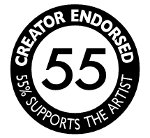 PNG / SVG / Encapsulated PostScript
PNG / SVG / Encapsulated PostScript
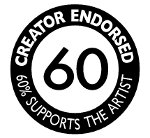 PNG / SVG / Encapsulated PostScript
PNG / SVG / Encapsulated PostScript
All available Creator-Endorsed Mark SVG files, by type:
- artist-10-percent
- artist-15-percent
- artist-20-percent
- artist-25-percent
- artist-30-percent
- artist-35-percent
- artist-40-percent
- artist-45-percent
- artist-50-percent
- artist-55-percent
- artist-60-percent
- artist-70-percent
- artist-75-percent
- artist-100-percent
- artists-25-percent
- artists-50-percent
- artists-75-percent
- artists-100-percent
- author-25-percent
- author-50-percent
- author-75-percent
- author-100-percent
- authors-25-percent
- authors-50-percent
- authors-75-percent
- authors-100-percent

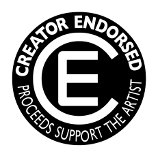
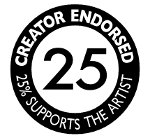
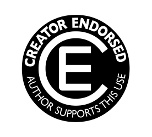
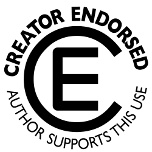
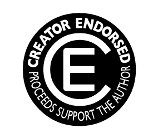
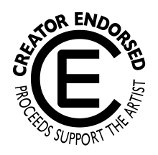
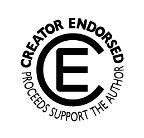

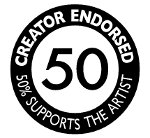

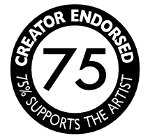
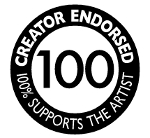
What about these variations?
“Creator endorsed — x% goes to charity”; just plain “Creator endorsed”; and the like, where money may go elsewhere or nowhere? For example, someone might endorse freely redistributing their music by BitTorrent and similar means in a nonprofit way. There are no “proceeds” in this case. (Or can one use the “100% supports the artist” on a technicality in this case? :))
Or was the idea mainly to use these on physical media, rather than electronic forms of distribution?
Yes, we plan to release non-monetary versions of the mark too. For now, just to keep it simple, and because there was some urgency to start using these, we’ve launched with the monetary versions.
All the marks are meant for both physical and electronic display.
-Karl Fogel
nice work here. I definitely agree with the ideology behind this design.
Is there any chance of SVG versions of these logos? EPS is not an open standard and is not usable format for some.
Oh, more than a chance. There will be scalable versions. We have some updated versions that I need to post first; then I’ll coordinate with Nina on getting SVG versions here.
By the way, I apologize — I didn’t realize EPS wasn’t an open standard. Can you describe the problems with it?
Still working on the SVGs, but we do have much larger PNGs available now — they should scale to most uses. More as soon as we have more.
First I must say I love this idea and what you are doing. This is such a momentous step in the right direction to help support artists in this new digital age. I had one question. Is there a different “creator endorsed” symbol between Nina’s original DVD versus someone else’s DVD who is also “creator endorsed” but decides to use the standard “creator endorsed” symbol over the “30% proceeds go to the artist” symbol? Is there someway to differentiate what is the creators original merch versus a creator endorsed merch? Does it even matter? Just curious what you think?
thanks again for putting these beautiful pieces together and great job on the film!
ben hicks
Thanks, Ben. We’re glad you like it!
The answer to your question is: the Creator-Endorsed Marks can mean whatever the permitting artist wants them to mean. That is, the terms of use for the marks state that it is the artist who gives others permission to use the marks on that artist’s works (presumably when distributing the works). If the artist wants to sign a contract with a distributor that allows the distributor to use the “30%” mark, then great. Most of the time, that contract will actually stipulate that 30% of something goes to the artist, but in the end it’s really up to the artist.
So for example, the symbol as it appears on our DVD distribution of Nina’s film was arranged between Nina and QuestionCopyright.org. She has similar contracts with other distributors.
If you’re an artist, you can give someone permission to use the same symbol when they distribute your works, but you don’t have to have exactly the same contract Nina has with us. It’s up to you.
If you’re a distributor, you can use the mark on an artist’s only with the permission of that artist — it’s as simple as that. How you get that permission is up to you. The obvious way is to give the artist some percentage of profits or revenue, but again, the terms of use merely encourage that, they don’t require it.
The relationship between artists and distributors can work however the two parties want. The point of the Creator-Endorsed Mark is to give artists some leverage in that relationship that’s independent of any monopoly (i.e., restrictive copyright) on their work.
Hi Karl,
I’m sorry I don’t think I was clear last time. I guess what I’m trying to say is that all of these seals say “creator endorsed”. To me “endorsed” means to “approve” of this merchandise/screening etc. This is all fantastic stuff but I’m wondering if it would also be beneficial to have a “creator original” seal.
I guess what I’m saying is that as a fan, if I see two seperate versions of the DVD both with “creator endorsed” seals. How do I know which is the one the artist created on their own versus the one the creator simply “approved of”. Do you see what I’m saying?
I would be more likely to purchase the one the creator made themselves over the version that is “approved” but in some cases it might be hard to distinguish which one is the “true” original.
Does that make sense?
thanks again
ben
me too, wonderful. we’re using similars at chianti.li
Numbers like 25% should always mean 25% of revenue, not 25% of profits (it’s always so easy to do some creative accounting to make profits zero…).
I agree. You can fatten the pockets of everyone, or even “lose” money on this particular endeavor while scurrying money away as if profit from other works. Then profits comes to $.01 per 1000 items, so they use the 100% mark by handing over this penny every 1000 items. Those paying for the expensive works, motivated thinking that the product is expensive because this is such a generous vendor, end up rewarding the wrong people. The real partner supporters suffer sales and maybe lose out in the market or drop the artist, fans get hoodwinked, and the artist suffers inexplicably. This is a bad deal for everyone trying to do the right thing while encouraging cheating in order to maximize profits. Remember, this is not theory. There are many arbitrary decisions that have to be made in accounting/billing. Any honest person in power that votes against investors in order to do the right thing will not last in that position long or ever be given such an account. Don’t pressure vendors to pick artist or investors (artists or survival in the market) when drawing an arbitrary line. You should make it as easy and objective for them as possible. All it takes is one “cheater” (going by the books) for everyone else to suffer.
[This comment can replace one made a bit earlier today. It includes the same general content but a little more clearly and better formatted. I must have rushed and not previewed properly last time.]
I agree, the % values should be based on revenue, not on profits. A vendor can create special positions or hire arbitrary contractors (eg, as a payoff to friends or even maybe to launder money) so as to break even or even “lose” money on some particular product or class of products.
Say profits comes to $.01 per 1000 items. This enables them to easily use the 100% mark by handing over this penny every 1000 items. Consumers paying for the expensive products from this firm, motivated thinking that the product is expensive because this is such a generous vendor, end up rewarding the wrong people. The real partner supporters suffer sales and maybe lose out in the market or drop the artist, fans get hoodwinked, and the artist suffers inexplicably.
This is a bad deal for everyone trying to do the right thing while encouraging cheating in order to maximize profits.
Remember, this is not theory. There are many arbitrary decisions that have to be made in accounting/billing. Any honest person in power that votes against investors in order to do “the right thing” will not last in that position long or ever be given such an account.
Don’t pressure vendors to pick between artists or investors (or between artists or survival in the market) when drawing an arbitrary line. You should make it as easy and objective for them as possible.
All it takes is one “cheater” (“going by the books”) for everyone else to suffer.
How about an “X supports the coder” variant? I would use it on the “canonical” version of open source software I write.